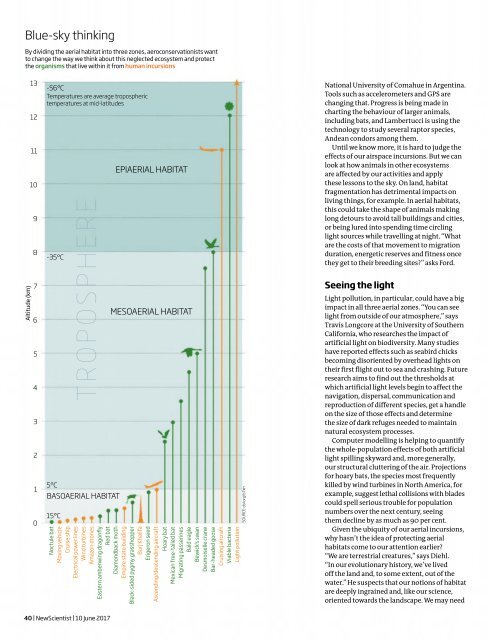New Scientist – June 10 2017
You also want an ePaper? Increase the reach of your titles
YUMPU automatically turns print PDFs into web optimized ePapers that Google loves.
Blue-sky thinking<br />
By dividing the aerial habitat into three zones, aeroconservationists want<br />
to change the way we think about this neglected ecosystem and protect<br />
the organisms that live within it from human incursions<br />
Altitude (km)<br />
13<br />
12<br />
11<br />
<strong>10</strong><br />
9<br />
8<br />
7<br />
6<br />
5<br />
4<br />
3<br />
2<br />
1<br />
0<br />
-56°C<br />
Temperatures are average tropospheric<br />
temperatures at mid-latitudes<br />
-35°C<br />
5°C<br />
BASOAERIAL HABITAT<br />
15°C<br />
TROPOSPH<br />
EPIAERIAL HABITAT<br />
MESOAERIAL HABITAT<br />
Noctule bat<br />
Moving vehicle<br />
Cruise ship<br />
Electrical power lines<br />
Wind turbines<br />
Amazon drones<br />
Eastern amberwing dragonly<br />
Red bat<br />
Diamondback moth<br />
Empire state building<br />
Black-sided pygmy grasshopper<br />
Burj Khalifa<br />
Erigeron seed<br />
Ascending/descending aircraft<br />
Hoary bat<br />
Mexican free-tailed bat<br />
Migrating passerines<br />
Bald eagle<br />
Bewick’s swan<br />
Desmoiselle crane<br />
Bar-headed goose<br />
Cruising aircraft<br />
Viable bacteria<br />
Light pollution<br />
SOURCE: doi.org/b7xn<br />
National University of Comahue in Argentina.<br />
Tools such as accelerometers and GPS are<br />
changing that. Progress is being made in<br />
charting the behaviour of larger animals,<br />
including bats, and Lambertucci is using the<br />
technology to study several raptor species,<br />
Andean condors among them.<br />
Until we know more, it is hard to judge the<br />
effects of our airspace incursions. But we can<br />
look at how animals in other ecosystems<br />
are affected by our activities and apply<br />
these lessons to the sky. On land, habitat<br />
fragmentation has detrimental impacts on<br />
living things, for example. In aerial habitats,<br />
this could take the shape of animals making<br />
long detours to avoid tall buildings and cities,<br />
or being lured into spending time circling<br />
light sources while travelling at night. “What<br />
are the costs of that movement to migration<br />
duration, energetic reserves and fitness once<br />
they get to their breeding sites?” asks Ford.<br />
Seeing the light<br />
Light pollution, in particular, could have a big<br />
impact in all three aerial zones. “You can see<br />
light from outside of our atmosphere,” says<br />
Travis Longcore at the University of Southern<br />
California, who researches the impact of<br />
artificial light on biodiversity. Many studies<br />
have reported effects such as seabird chicks<br />
becoming disoriented by overhead lights on<br />
their first flight out to sea and crashing. Future<br />
research aims to find out the thresholds at<br />
which artificial light levels begin to affect the<br />
navigation, dispersal, communication and<br />
reproduction of different species, get a handle<br />
on the size of those effects and determine<br />
the size of dark refuges needed to maintain<br />
natural ecosystem processes.<br />
Computer modelling is helping to quantify<br />
the whole-population effects of both artificial<br />
light spilling skyward and, more generally,<br />
our structural cluttering of the air. Projections<br />
for hoary bats, the species most frequently<br />
killed by wind turbines in North America, for<br />
example, suggest lethal collisions with blades<br />
could spell serious trouble for population<br />
numbers over the next century, seeing<br />
them decline by as much as 90 per cent.<br />
Given the ubiquity of our aerial incursions,<br />
why hasn’t the idea of protecting aerial<br />
habitats come to our attention earlier?<br />
“We are terrestrial creatures,” says Diehl.<br />
“In our evolutionary history, we’ve lived<br />
off the land and, to some extent, out of the<br />
water.” He suspects that our notions of habitat<br />
are deeply ingrained and, like our science,<br />
oriented towards the landscape. We may need<br />
40 | <strong>New</strong><strong>Scientist</strong> | <strong>10</strong> <strong>June</strong> <strong>2017</strong>


















